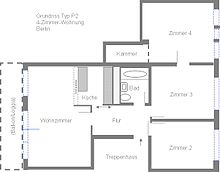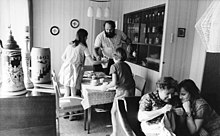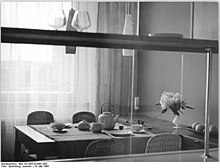P2 (panel type)

P2 is the abbreviation for the residential type of a prefabricated building in the GDR . The P stands for parallel , the load-bearing walls are arranged parallel to the facade surfaces. And the 2 refers to the arrangement of two staircases in a building. A number after the slash indicates the number of floors. This industrial construction enabled entire apartment blocks to be built quickly. It was used in many large cities from 1961 until the end of the GDR.
history
The first house of this type of industrial construction was built in 1961 as an experimental building in Berlin-Lichtenberg by an architects' collective from the Building Academy of the GDR , including Achim Felz , Herbert Kuschy and Wilfried Stallknecht . The building train is located at Erich-Kuttner-Straße 9–15 in the Fennpfuhl district and is now a listed building .
While the experimental building still had four different floor plans, the basic principle of a ceiling span of 6 meters was later created to simplify the building. The load-bearing house walls thus became apartment partition walls at the same time and the inner partition walls were variable. In the further development of this type of building, the architects varied the number of floors. In addition, wedge-shaped floor plans were created that could be inserted to allow the wings to bend.
construction

Stairs and arrangement of the apartments
A characteristic of this type is the arrangement of the apartments around an internal, almost square staircase , often with a glass roof . The buildings have five to eleven floors . There are usually two apartments per floor, but modifications of this type of house with three apartments per floor above and below the stairwell access have also been implemented.
Floors

As a standard construction, the P2 has five / six storeys, with the ground floor protruding half a storey from the site. This minimized the excavation in the area when laying the foundations of the buildings and enables natural ventilation and lighting of the cellars. The building is therefore accessed either via external stairs and / or a half-staircase in the entrance area. The stairwell and its necessary access required the area of an apartment to be reduced on the ground floor. For this reason, mostly a 4-room and a 1-room apartment were created from the symmetrical 3-room apartments on the upper floors. The missing room is designed as a hallway.
In P2 buildings with more than six floors, all three floors have a distribution corridor. This is usually on the entrance side of the building and forms the entrances to stairwells, elevators, rubbish chutes and storage rooms. The apartments above or below the distribution aisles cannot be reached directly from the elevator, but rather via stairs up or down. The distribution corridors are typically in the following arrangement:
- P2 / 7 (with 7 floors): 1st, 3rd and 6th (evacuation passage on the 6th floor)
- P2 / 10 (with 10 floors): 1st, 3rd, 6th and 9th floors
- P2 / 11 (with 11 floors): 1st, 4th, 7th and 10th floors. On the 7th floor there is an evacuation corridor at the same level, which connects to a neighboring building and serves as an escape route .
The architects installed rubbish chutes next to the elevator doors , which means that waste can be disposed of in a short and weather-independent manner . After the political change , these shafts were closed in some of the buildings because they no longer complied with the new hygienic regulations. For example, in P2 residential buildings belonging to the Lichtenberg housing association, these entrances were retained after tenant protests and a special permit from the Senate and provided with an additional (separate) chamber. The shaft linings and throw-in containers were renewed.
Apartment types
Standard was the equipment with 1- to 4-room apartments. In houses with special elements, for example in a trapezoidal shape , there are also 5-room apartments in which two rooms do not have right angles in the floor plan.
There were no loggias on the mezzanine floor ; they were only added during later reconstruction work after the fall of the Wall .
Kitchen and Bathroom
A novelty were the bathrooms and kitchens of the houses, which were inside and basically next to each other, so that they could use a common supply shaft for water, sewage and ventilation, thus saving space.
The designers did without a kitchen-cum-living room , which requires long distances and spatially separates the family. In addition, living space and thus costs should be saved. The basic idea was to better integrate the woman into the family, as the kitchen was designed to be open to the living room. The man should be encouraged to participate in the household. Life should no longer take place at the stove, but in the living room. The kitchens were initially connected to the living room by large hatches in the form of built-in furniture. After massive criticism that the kitchen was not sufficiently separated from the living room, concrete walls with a small hatch window were later used; in the last built apartments of this type, the kitchen was completely separated from the living room by a wall. She received daylight only indirectly through the door or the hatch.
For the first time, fully equipped sanitary rooms ( toilet , sink, bathtub, fittings for bathroom and kitchen, washing machine connection, vertical supply and disposal lines) were used for the bathrooms , which were lifted into the shell in one piece . All that was required for installation was the connection of the pipes at floor level. The walls to the supply shaft were made of different materials. They range from chipboard to solid plaster walls to solid concrete elements.
Technical specifications
- Finished parts in the load level up to 5.0 t
- Basic grid 6 m × 6 m
- Building depth (standard) 12 m
- Floor height 2.60–2.80 m
- Number of floors: 5 to 11, with shop and office floors also 14
literature
- Susanne Hopf, Natalja Meier: Plattenbau private. 60 interiors . Nicolai, Berlin 2004. ISBN 3-89479-130-6
- Roland Enke: new living - new living - the model and experimental building P 2 in Berlin-Lichtenberg . In: The Bear of Berlin , Yearbook of the Association for the History of Berlin, 54.2005, pp. 153–166. ISSN 0522-0033
Web links
Individual evidence
- ↑ Architectural monument experimental building P2 in Erich-Kuttner-Strasse 9–15, tenement house. 1961/1962 by Achim Felz, Herbert Kuschy and Wilfried Stallknecht
- ^ Danuta Schmidt: Design for life. In: Neues Deutschland , August 12, 2013.
- ↑ Panel building study P2



